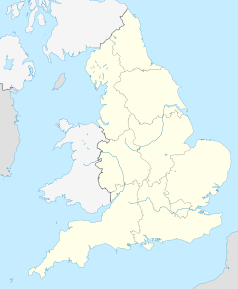Marble Arch
 Marble Arch (2009) | |
| Państwo | |
|---|---|
| Kraj | |
| Miejscowość | |
| Typ pomnika | |
Położenie na mapie City of Westminster Contains Ordnance Survey data © Crown copyright and database right, CC BY-SA 3.0 | |
Położenie na mapie Wielkiej Brytanii (c) Karte: NordNordWest, Lizenz: Creative Commons by-sa-3.0 de | |
Położenie na mapie Wielkiego Londynu Contains Ordnance Survey data © Crown copyright and database right, CC BY-SA 3.0 | |
Marble Arch – marmurowy łuk triumfalny w Londynie, w City of Westminster, ustawiony przy skrzyżowaniu Oxford Street, Park Lane i Edgware Road, na krańcu Hyde Parku. Do 1851 stał przed Buckingham Palace. W przeszłości jedynie członkowie rodziny królewskiej i oddziały Królewskiej Artylerii Konnej były przepuszczani pod łukiem, podczas uroczystych pochodów. Nazwa "Marble Arch" odnosi się także do okolicy, w której monument się znajduje. Nazwę zapożyczyła również pobliska stacja metra.
Projekt
Łuk został zaprojektowany w 1825 roku, na wzór rzymskiego Łuku Konstantyna Wielkiego przez brytyjskiego architekta Johna Nasha[1]. Stanowił ceremonialną bramę wjazdową na dziedziniec nowo powstałego Buckingham Palace. Pałac otaczał dziedziniec z trzech stron, Marble Arch umieszczono od wschodniej, otwartej strony.
Budowa Marble Arch była częścią programu mającego na celu uczczenie brytyjskich zwycięstw w wojnach napoleońskich[2]. Model łuku, powstały około 1826 roku, znajduje się w Muzeum Wiktorii i Alberta[3].
Na szczycie łuku miała stanąć rzeźba króla Jerzego IV, autorstwa angielskiego rzeźbiarza Johna Flaxmana. Po jego śmierci w 1826 roku zlecenie zdobienia łuku podzielono pomiędzy rzeźbiarzy: Sir Richarda Westmacotta, Edwarda Hodgesa Baily'ego i J.C.F. Rossi'ego. Pomnik konny króla wykonał Francis Leggatt Chantrey[4].
Budowa
Budowa rozpoczęła się w 1827 roku, jednak została przerwana w 1830 roku z powodu rosnących kosztów. Prace wznowione w 1832 roku, pod nadzorem Edwarda Blore'a, który znacznie zredukował projekt Nash'a, m.in. pomijając rzeźbę Jerzego IV. Łuk został ukończony w 1833 roku[2].
Niektóre niewykorzystane rzeźby znalazły swoje miejsce w innych londyńskich konstrukcjach. Fryz Richarda Westmacotta zdobiony płaskorzeźbą przedstawiającą bitwę pod Waterloo oraz tablica Nelsona znajdują się na Buckingham Palace[5]. Dzieła Johna Rossi'ego przeniesiono do National Gallery, a pomnik Jerzego IV stanął na jednym z piedestałów na Trafalgar Square[6].
Przeniesienie
Łuk został zdemontowany w 1850 roku, kiedy wschodnie skrzydło Buckingham Palace zostało zbudowane. Przeniesienie i rekonstrukcja Marble Arch na wschodnim krańcu Hyde Parku została ukończona w marcu 1851 roku. Trzy małe pomieszczenia znajdujące się wewnątrz budowli zostały zaadaptowane na posterunek policji, który pozostał tam do 1950 roku[2].
Przypisy
- ↑ John Timbs: London and Westminster: City and Suburb. 1868. s. 190-191. [dostęp 2012-02-24].
- ↑ a b c Marble Arch. English Heritage. [dostęp 2012-02-24]. (ang.).
- ↑ Marble Arch: Architectural model. Victoria and Albert Museum Collections. [dostęp 2012-02-24]. (ang.).
- ↑ Chantrey, Sir Francis Legatt (1781-1841) Knight Sculptor. The National Archives. [dostęp 2012-02-24]. (ang.).
- ↑ Sir Richard Westmacott (1775-1856). The Victorian Web. [dostęp 2012-02-24]. (ang.).
- ↑ Peter Cunningham: Handbook of London: past and present, Tom 1. John Murray. s. 87. [dostęp 2012-02-24]. (ang.).
Media użyte na tej stronie
Contains Ordnance Survey data © Crown copyright and database right, CC BY-SA 3.0
Blank map of the City of Westminster, showing the electoral wards used from 2002 to 2022.
Equirectangular map projection on WGS 84 datum, with N/S stretched 160%
Geographic limits:
- West: 0.22W
- East: 0.1W
- North: 51.55N
- South: 51.48N
(c) Karte: NordNordWest, Lizenz: Creative Commons by-sa-3.0 de
Location map of the United Kingdom
Contains Ordnance Survey data © Crown copyright and database right, CC BY-SA 3.0
Map of Greater London, UK with the following information shown:
- Administrative borders
- Coastline, lakes and rivers
- Roads and railways
- Urban areas
The data includes both primary routes and railway lines.
Equirectangular map projection on WGS 84 datum, with N/S stretched 160%
Geographic limits:
- West: 0.57W
- East: 0.37E
- North: 51.72N
- South: 51.25N
Flag of England. Saint George's cross (a red cross on a white background), used as the Flag of England, the Italian city of Genoa and various other places.
Symbol pomnika do legendy mapy
Autor: Original uploaded by VAwebteam (Transferred by Sergiodc), Licencja: CC-BY-SA-3.0
Architectural model, about 1826 designed by John Nash V&A Museum no. A.14-1939
Techniques -Cast plaster
Place -London, England
Dimensions -Height 72.5 cmWidth 59 cmDepth 30.5 cm
Object Type -This is the model for the Marble Arch, today at the top of London's Park Lane, but originally located outside Buckingham Palace. It is uncertain who made the model, although it is to the design of the architect John Nash (1752-1835). The chief sculptors employed to produce reliefs for the arch were E. H. Baily (1788-1867) and Sir Richard Westmacott (1799-1857). The arch was erected as a celebration of Wellington's and Nelson's victories respectively. The foundations of the Arch were laid in 1828, but it was not completed until about 1833. The bronze equestrian figure of George IV surmounting the arch, executed by Sir Francis Chantrey (1781-1841), was removed when the Arch was taken to its present position, and re-erected in Trafalgar Square.
People -John Nash was probably born in London, and was first employed in the office of the architect and sculptor Sir Robert Taylor, but he left his employ, and relatively early in life, in 1777, he set up independently as an architect and speculative builder in London. However in 1783 he was declared bankrupt, and moved to Carmarthen in Wales. Here he had some successful commissions, and returned to London in 1796. He formed a partnership with the landscape gardener Humphry Repton (1752-1818), and together they transformed country houses and their parks into elegant picturesque seats. In 1806 he was made architect to the Department of Woods and Forests, and in this capacity became responsible for designing Regent's Park, London, for the Prince Regent in 1811. He designed Regent Street in 1813. When George IV died in 1830, Nash's career as a public architect was virtually at an end.
Models -Small-scale models for monuments and buildings were made in order to help the architect or sculptor plan the work, as well as to show the patron the likely look of the finished commission.
Source: https://collections.vam.ac.uk/item/O77788/architectural-model/














